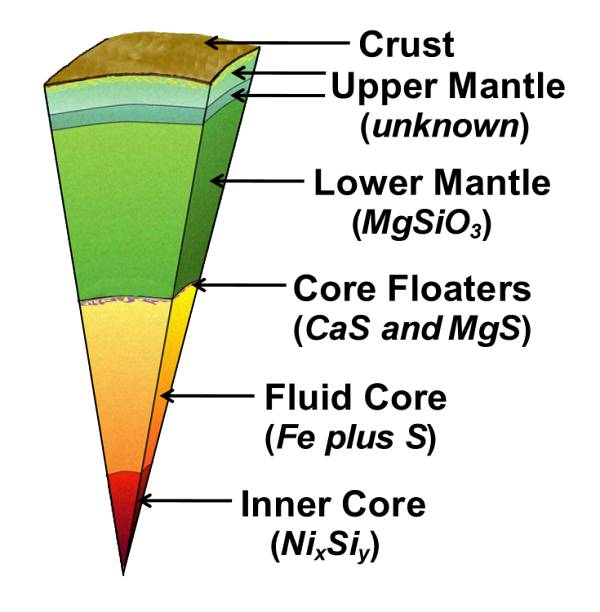  J. Marvin Herndon's Discovery of the Compositions of Earth's Interior Parts |
|
|
In the illustration at right, the seismic speeds of the shear waves are indicated by a dashed line, the compression waves by a solid line. Believing as Birch did that the Earth's mantle is of uniform composition, geophysicists since have attempted to explained these layers as "phase changes", different crystal structures of the same chemical composition produced by pressure caused by the overburden weight of the mantle above. Bullen also discovered a narrow band between the lower mantle and the core where seismic "irregularities" occur.
After an inspiring conversation with Inge Lehmann, Herndon, pictured at left, progressed through the following logical exercise: If the inner core is in fact the compound nickel silicide, as he had suggested (click here for pdf), then the Earth's core must be like the alloy portion of an enstatite chondrite meteorite. If the Earth's core is in fact like the alloy portion of an enstatite chondrite, then the Earth's core must be surrounded by a silicate-rock shell, like the silicate-rock portion of an enstatite chondrite. But the enstatite chondrite type of silicate-rock is essentially devoid of oxidized iron (FeO), unlike the silicate-rock of the upper part of the upper mantle, which contains appreciable FeO. Thus, the Earth's enstatite-chondrite-like silicate-rock shell, if it exists, should be bounded by a seismic "discontinuity", the boundary where earthquake waves change speed and direction because of the different compositions.
In 1980, J. Marvin Herndon first published the discovery of that identity in the
Proceedings of the Royal Society of London in an article entitled "The
Chemical The vertical axis of the figure at left shows the weight percent alloy of each of 157 ordinary chondrites (shown as open circles) and 10 enstatite chondrites (shown as filled circles). The dashed lines show the points on the vertical axis which correspond to the Earth's core, expressed as weight percent of the whole Earth and as weight percent of the Endo-Earth (lower mantle plus total core). This figure shows that the alloy weight percent of the Earth's core is consistent with that for enstatite chondrites, like the Abee meteorite. It also shows that the Earth cannot be like an ordinary chondrite, as was assumed by Francis Birch and many who followed him.
When the Earth formed, and when the matter of certain enstatite chondrites formed, the availability of oxygen was so limited that some normally lithophile "rock-loving" elements could not find oxygen and were thus constrained to reside in the alloy, in the core. The trace element uranium (U) was among these. Generally lithophile elements are incompatible in an iron alloy and tend to precipitate out. How these elements precipitate out, as described by J. Marvin Herndon, determines the structures within the Earth's core.
The lower mantle consists of mainly of enstatite (MgSiO3), like the silicate of the Abee enstatite chondrite, but in a different (perovskite) crystal structure because of the pressure by the weight above. Like the Abee-silicate, the lower mantle has essentially no oxidized iron (FeO). Now consider the Earth's fluid core. Imagine, for sake of discussion, that at some point in the past the Earth's core was so hot that all of its elements were dissolved in the liquid iron alloy. As the Earth's core began to cool, the incompatible elements would begin to precipitate out. At a high temperature, calcium (Ca) and magnesium (Mg) would grab sulfur to precipitate as CaS and MgS and, being less dense, would float to the top of the core, causing the seismic "irregularities" observed there. Other highly incompatible trace elements, such as uranium, would find a thermodynamically feasible way to precipitate. At a somewhat lower temperature, under appropriate conditions, silicon (Si) and nickel (Ni) would combine and precipitate, settling downward, forming the Earth's nickel silicide inner core. In the Birchian view of the Earth being like an ordinary chondrite, on the other hand, the parts of the core are inexplicable without making ad hoc assumptions for which there is no corroborating evidence. |
| References | |
| 1. |
Lehmann, I., P'. Publ. Int. Geod. Geophys. Union, Assoc. Seismol., Ser. A, Trav. Sci., 1936, 14, 87-115. |
| 2. | Birch, F., The transformation of iron at high pressures, and the problem of the Earth's magnetism. American Journal of Science, 1940, 238, 192-211. |
| 3. | Herndon, J. M., The nickel silicide inner core of the Earth. Proceedings of the Royal Society of London, 1979, A368, 495-500. (click here for pdf) |
| 4. | Herndon, J. M., The chemical composition of the interior shells of the Earth. Proceedings of the Royal Society of London, 1980, A372, 149-154. (click here for pdf) |
| 5. | Herndon, J. M., The object at the centre of the Earth. Naturwissenschaften, 1982, 69, 34-37. |
| 6. | Herndon, J. M., Feasibility of a nuclear fission reactor at the center of the Earth as the energy source for the geomagnetic field. Journal of Geomagnetism and Geoelectricity, 1993, 45, 423-437. (click here for pdf) |
| 7. | Herndon, J. M., Sub-structure of the inner core of the Earth. Proceedings of the National Academy of Sciences USA, 1996, 93, 646-648. (click here for pdf) |
| 8. | Herndon, J. M., Composition of the deep interior of the Earth: Divergent geophysical development with fundamentally different geophysical implications. Physics of the Earth and Planetary Interiors, 1998, 105, 1-4. |
| 9. | Herndon, J. M., Scientific basis of knowledge on Earth's composition. Current Science, 2005, 88, 1034-1037. (click here for pdf) |
| 10. | Herndon, J. M., Geodynamic basis of heat transport in the Earth. Current Science, 2011,101, 1440-1450. (click here for pdf) |
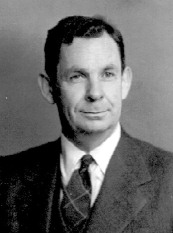
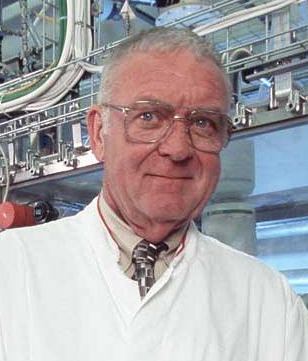
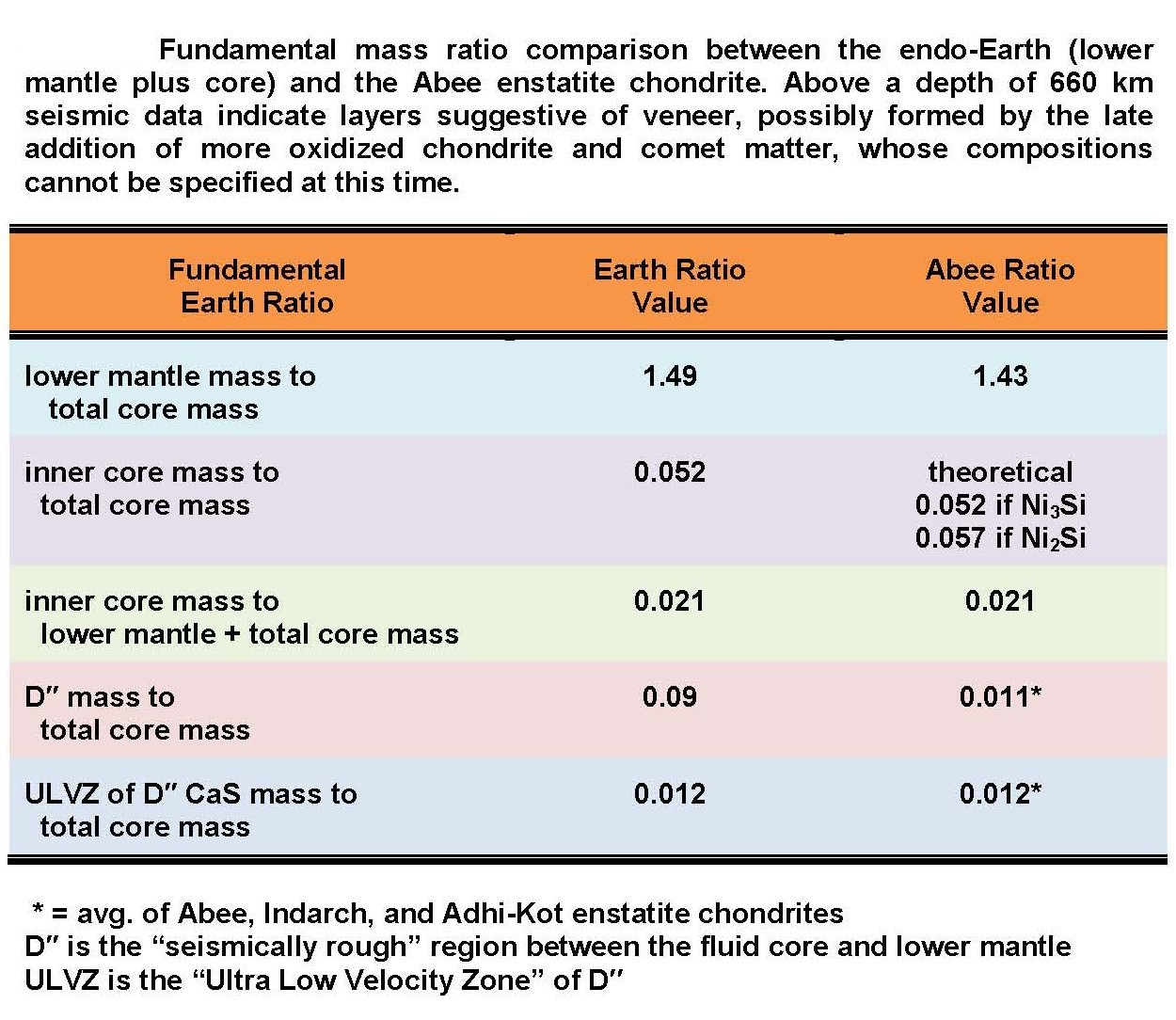 Using only the mass of the Earth's
core, and the silicate-rock to alloy ratio of the Abee enstatite
chondrite, Herndon calculated the mass of the Earth's
enstatite-chondrite-like silicate-rock shell and found it virtually
identical to the mass of the Earth's lower mantle. He calculated the
boundary to within about 1.2% of the radius of the seismic discontinuity
that separates the lower mantle from the upper mantle. The table at left
shows the comparison between the fundamental mass ratios of the inner
82% of the Earth, the region below the seismic boundary that separates
the upper and lower mantle. What this means is that the Endo-Earth, the
inner 82% of the Earth, is like the Abee enstatite chondrite and the
chemical compositions of Endo-Earth parts can be estimated from
compositions of corresponding Abee parts [4-10].
Using only the mass of the Earth's
core, and the silicate-rock to alloy ratio of the Abee enstatite
chondrite, Herndon calculated the mass of the Earth's
enstatite-chondrite-like silicate-rock shell and found it virtually
identical to the mass of the Earth's lower mantle. He calculated the
boundary to within about 1.2% of the radius of the seismic discontinuity
that separates the lower mantle from the upper mantle. The table at left
shows the comparison between the fundamental mass ratios of the inner
82% of the Earth, the region below the seismic boundary that separates
the upper and lower mantle. What this means is that the Endo-Earth, the
inner 82% of the Earth, is like the Abee enstatite chondrite and the
chemical compositions of Endo-Earth parts can be estimated from
compositions of corresponding Abee parts [4-10].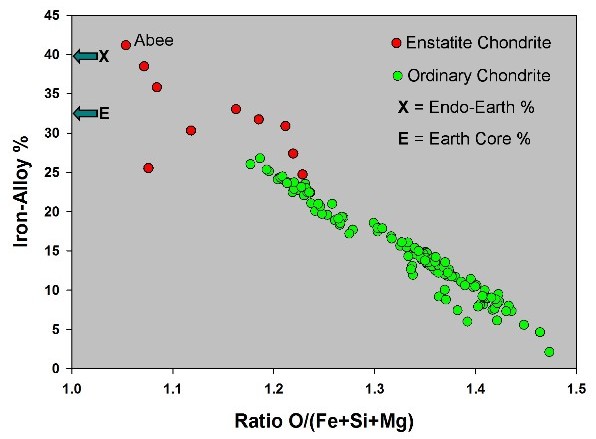 Composition of of the Interior Shells of the Earth"
Composition of of the Interior Shells of the Earth"
